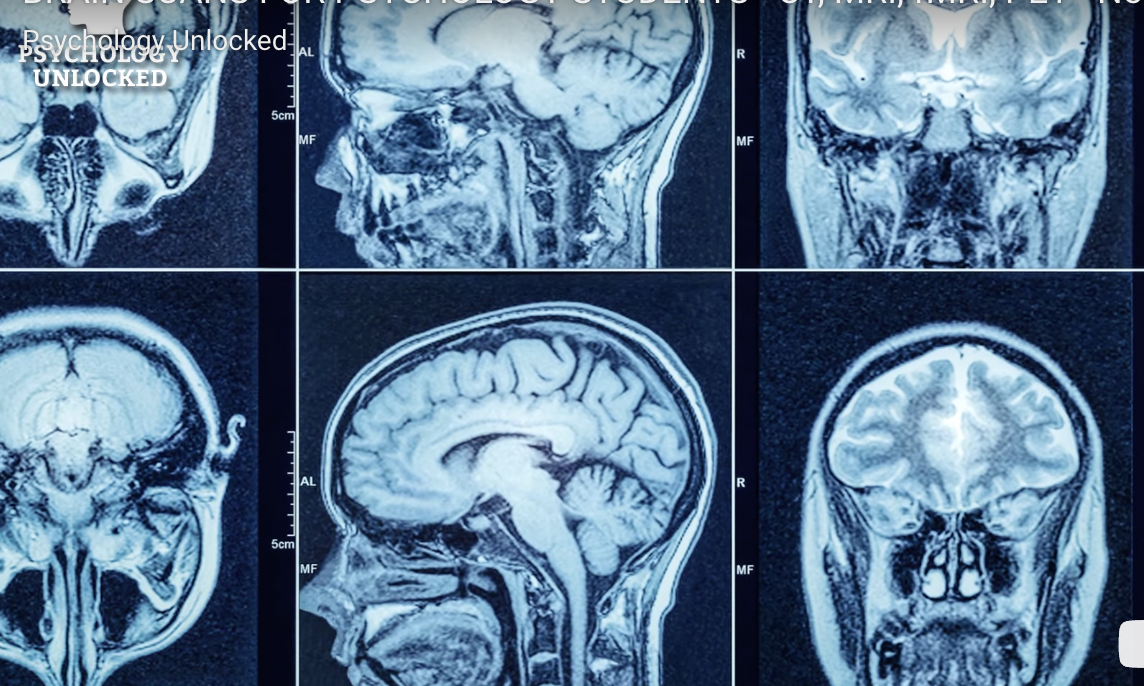AP Psychology Exam Mega Guide
1/854
Earn XP
Name | Mastery | Learn | Test | Matching | Spaced |
|---|
No study sessions yet.
855 Terms
Neuron Diagram
(Memorize the anatomy)
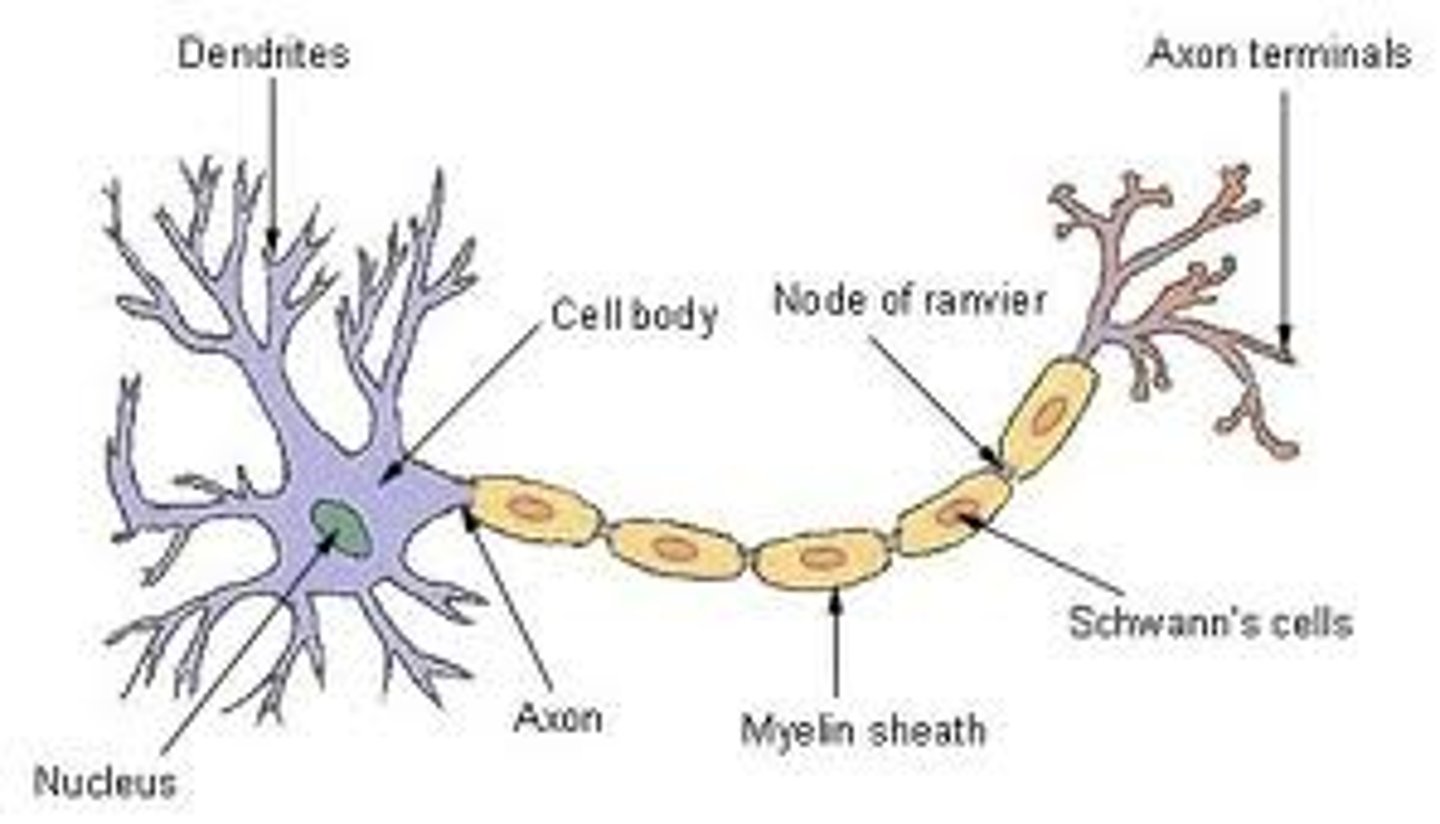
Endocrine System
The body's "slow" chemical communication system; a set of glands that secrete hormones into the bloodstream.
As "slow as the mail" in terms of changes, whereas the nervous system is jittery, fast, and quick.
Diagram of the nervous system

Evolutionary Psychology:
The study of evolutionary human nature and characteristics to determine how we behave today.
Uses the theory of natural selection to explain certain behaviors.
Diathesis:
Related psychological disorders.
Many disorders can have a common predisposition between them or environmental triggers.
Genomes:
The complete instructions for making an organism (the "blueprint")
Fraternal (Dizygotic) twins:
Individuals that developed from two separate fertilized eggs. They are no different from ordinary siblings.
Why are twins specifically studied in epigenetics?
Because a set of twins' genetic makeup is largely if not wholly identical, but they will experience different environmental changes which in turn can show which of their genes are "turned on" or "turned off".
Also, it's unethical for scientists to artificially separate twins or do experiments to determine nature vs. nurture; looking at twins is like a "naturally existing" experiment.
Adoptee parents are least likely to share/pass down their _____ to their adopted children
Personality - This is most influenced by genetic parents. (Without a doubt, adoptee parents CAN influence their children, but their predisposition in personality will be mostly based on their genetics.).
Neurons:
Specialized brain cells that are the building blocks of teh nervous system.
Cell body:
The part of a neuron that contains the nucleus, the cell's life support center.
Dendrites:
The bushy, branching extensions at the ends of a neuron which integrate and communicate messages between cells, conducting impulses towards the cell body.
Axon:
The segmented neuron "pathway" that passes messages through its branches to other neurons or to muscles or glands.
They have ends that look like dendrites but are not. *They are called Axon terminals, like airport gateway/terminals*
Myelin sheath:
The fatty tissue layer that covers the axons of some neurons. This coating is like a rubber cover around the wires of a charger; this facilitates greater transmission speed between neural impulses.
Multiple sclerosis attacks the myelin sheath.
Nervous System
The body's speedy, electrochemical communication network, consisting of all the nerve cells of the peripheral and central nervous systems.
Fast like a text message, whereas hormones are as slow as the mail.
Central nervous system (CNS)
The brain and spinal cord. Thinking, feeling, and acting are all routed through the CNS.
Peripheral nervous system (PNS)
The sensory and motor neurons that connect the central nervous system to the rest of the body (literally everything else other than the brain and spinal cord)
Nerves
Bundled axons that form neural "cables" connecting the central nervous system with muscles, glands, and sense organs (think wires).
Nerves are like highways.
Types of neurons:
sensory neurons, motor neurons, interneurons
Interneurons
Neurons within the brain and spinal cord that communicate internally and intervene between the sensory inputs and motor outputs
Think of them as the glue between motor neurons and sensory neurons.
There are billions of interneurons and only millions of motor/sensory neurons
Mirror neurons
Frontal lobe neurons that fire when performing certain actions or when observing another doing so. The brain's mirroring of another's action may enable imitation, language learning, and empathy.
The peripheral nervous system is divided into two main divisions: ____ and ____
Somatic and autonomic
Somatic (skeletal) nervous system
The part of the PNS that carries sensory input from receptors to the CNS and relays commands from the CNS to skeletal muscles to control their movement
Autonomic (automatic) nervous system
The part of the PNS that controls the glands and the muscles of the internal organs in order to maintain homeostasis (equilibrium). Automatic.
Divided into two divisions - The sympathetic and parasympathetic nervous system
Sympathetic vs parasympathetic nervous system (In ANS)
The sympathetic nervous system prepares the body for intense physical activity and is often referred to as the fight-or-flight response. It sympathizes with you and wants to protect you, leading you to fight-flight reactions.
The parasympathetic nervous system has almost the exact opposite effect and relaxes the body and inhibits or slows many high energy functions. It's a parachute that floats you back down to earth and tells you "it's okay".
Reflex
A simple, automatic response to a sensory stimulus, such as the knee-jerk response
Psychology:
The science of behavior and mental processes.
All things psychological are simultaneously biological.
Nature-nurture:
The long-standing debate of which factor influences the development of psychological traits and behaviors.
Scientists are now confident that they are both just as important, rather than one over the other.
Natural selection:
The principle that the inherited traits enabling an organism to best survive (or be the "best fit") and reproduce will likely be passed onto future generations.
In short: Survival of the fittest will often win.
Genes and environment collaborate to help ensure the best chance of fitness.
Mutation:
An error in one's genetic code which results in an anomaly.
Behavioral Genetics:
The study of how genetics influences one's behavior.
Genetic combinations and variations DO help explain certain behavior, but because we are a complicated species, we are also influenced by our adaptations, lessons, and experiences.
Charles Darwin:
Not quite a psychologist, but proposed that natural selection allows for traits that give the best chances of one's fitness and thus survival, as well as for them to be passed down.
Natural selection is influenced by both genetic inheritance and environment.
Environment:
Every nongenetic influence, from prenatal nutrition to our experiences of the people and things around us.
Heredity:
The genetic transfer of traits from parents to offspring. People have genetic predispositions, but often, traits are mostly assigned by chance.
Intergenerational Trauma:
Traumatic experiences passed from generation to generation.
The trauma affects the first generation's DNA and mental processes, anxieties, which in turn translate to their subsequent generations, EVEN if the new generations haven't interacted with the stressor before.
New generations are innately BORN with fear to protect themselves.
Common example: Mice's predisposition to being terrified of cats
Epigenetics:
(Above, "epi", genetics). The ability of environmental stressors or variables to affect whether certain genes are turned on or off.
Environmental pressures can change the activity of genes, NOT the structure (it only determines if certain things are expressed; if it's turned on or off)
DNA STAYS THE SAME. It's just that how that DNA is interpreted (genes) is changed.
These changes influence behaviors and traits
These changes are transgenerational
Polygenic:
Many genes; a behavior or traits are likely caused by many genes
Maturationism:
All children follow the standard pattern of growing up (ex. They crawl, then walk)
Plasticity:
The ability of environmental stressors or variables to affect the structure of genes
The elastic nature of the brain in that it rearranges itself on a cellular level to respond to environmental stimuli or stress.
Genes:
The biochemical units of heredity
Epigenetics vs. Plasticity
Epigenetics :
- The ability of environmental stressors or variables to affect whether certain genes are turned on or off
- Slowly changes over time
- For the betterment of the species
Plasticity:
- The ability of environmental stressors or variables to affect the structure of genes
- Quickly changes
- For the betterment of the species (Learning and creating new pathways in the brain)
Eugenics:
Outdated and unethical practice which allowed for an artificial selection of traits (through sterilization and deliberate manipulation) to gain "ideal traits"
Rooted in racism
Monozygotic (Identical) twins:
Individuals that developed from a single fertilized eggs which then splits into two genetically identical organisms
Interaction:
The overlap that occurs when an effect of one factor (ex. the environment) depends on another factor (such as heredity or genetics).
You and Dr. Miron will share ____ of your genetic makeup.
Nearly all. No more than 5% of human genetic differences arise from population group differences.
Sensory (afferent) neurons
neurons that carry incoming information from the sensory receptors to the brain and spinal cord
Output -> Input (Stimuli from the OUTSIDE world is interpreted INSIDE)
Motor (efferent) neurons
neurons that carry outgoing information from the brain and spinal cord to the muscles and glands
Input -> Output (Stimuli from the INSIDE, such as messages from brain and spine, is interpreted OUTSIDE and translated into motion)
Neural networks
Networks of clusters of nerve cells that integrate sensory input and motor output
How do neurons reinforce or grow connections?
By strengthening a pathway between them through prompting constant communication
What does the spinal cord control?
Reflexes, such as pain reflexes, and brings impulses from the nerves to the brain.
Diathesis
The nature of disorders or diseases to have a predisposition or environmental triggers in common.
Glial cells (Glia)
Support cells that provide support and protection for neurons.
Their job is restoring them, feeding them, creating more myelin, guiding connections, and cleaning their environment.
Despite being labelled support cells, they play a crucial role in learning, thinking, and memory that their label undermines.
Action potential
A neural impulse; an electrical charge that shoots across the axon.
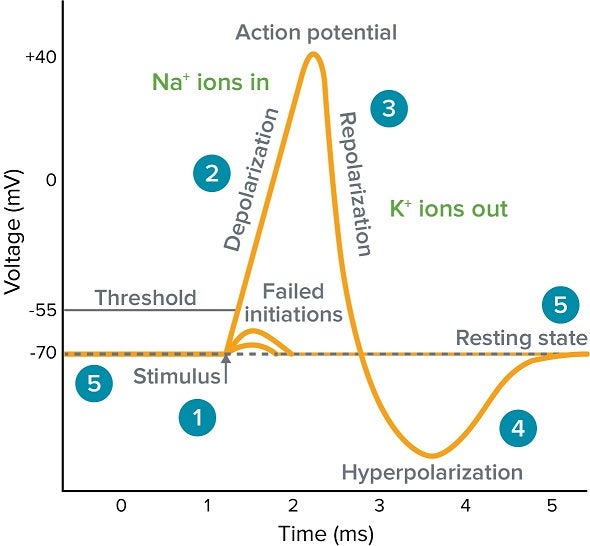
Threshold
The level of stimulation needed to trigger a neural impulse.
A certain amount of stimulation needed to trigger a neural impulse.
Refractory period
A brief recovery period that occurs after a neuron has fired a signal.
NOTHING happens during the refractory period; it needs a break from the firing. It is a period of rest; after the period ends, then action can continue again.
Subsequent action potentials (charges) cannot occur until the axon returns back to its original state of rest.
All or none response
The nature of a neuron to either fire with all of its strength or just not fire at all. It either happens or doesn’t happen.
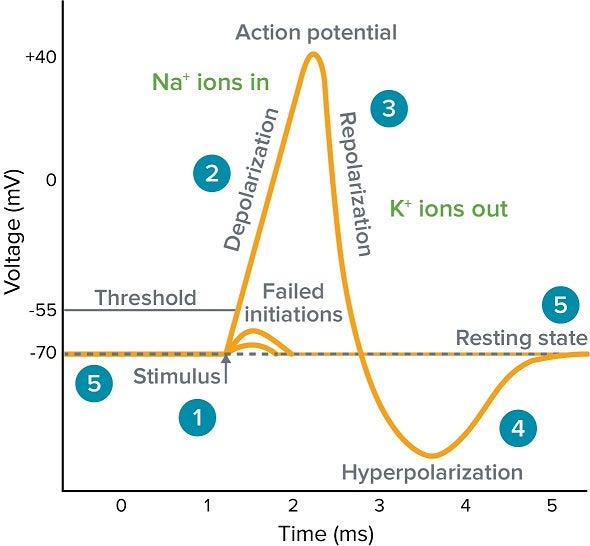
Action Potential Sequence
What is the Process?
1) Stimulation occurs
2) Depolarization (Destress) (Na+ ions in —- you become salty, salt comes in)
3) Repolarization (Recharge) (K+ ions out), action potential fires
4) Hyperpolarization
5) Resting state (Refractory period)
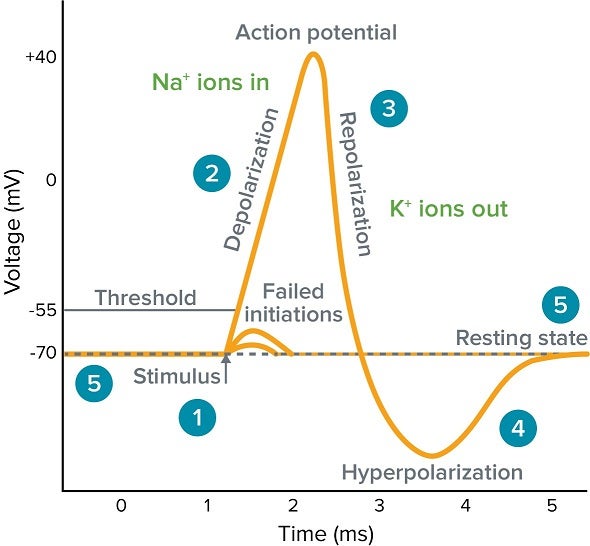
Neurogenesis
The formation of new neurons.
Prompted by healthy habits like exercise and eating healthy
Neural membrane
The membrane that allows an influx and outflux of ions.
It has gated and leak channels— Sodium ions come in, potassium goes out
During the resting phase, the charge of a neuron is...
Negative
Depolarization of a neuron happens when...
Na+ flows in and K+ is pumped out.
Which of the following happens immediately after an action potential begins?
Gated sodium channels open and Na+ flows in.
Which of the following best describes the refractory period?
The neuron can’t respond to an action potential.
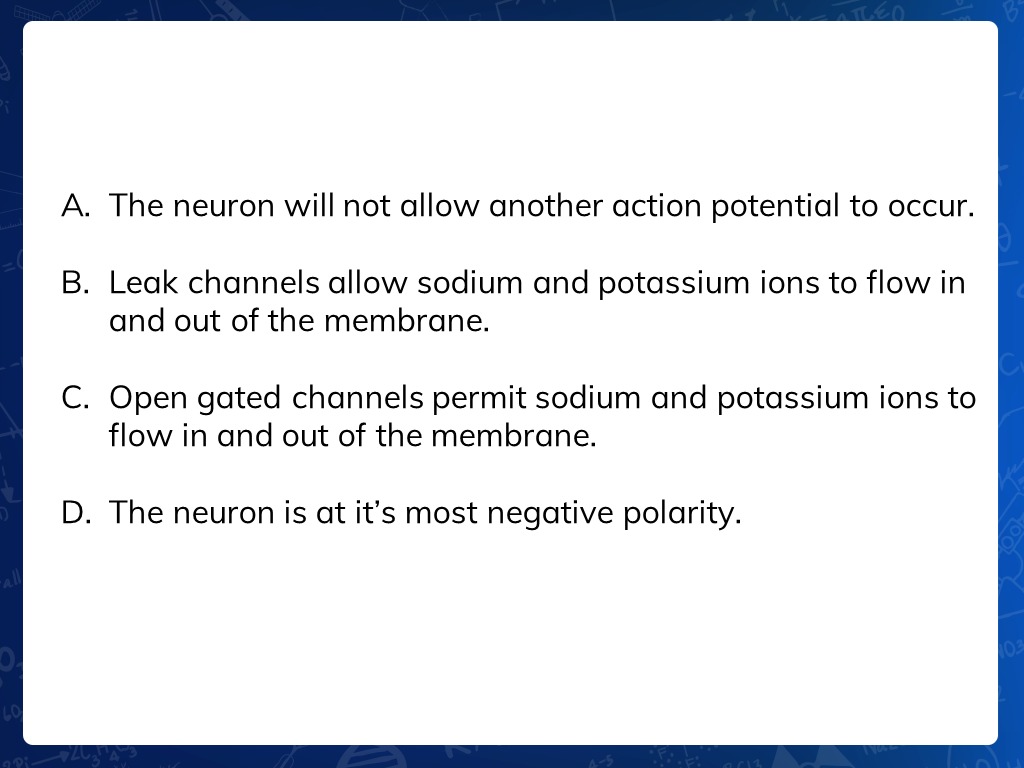
See reference image. Which best describes a neuron during its resting phase?
B only
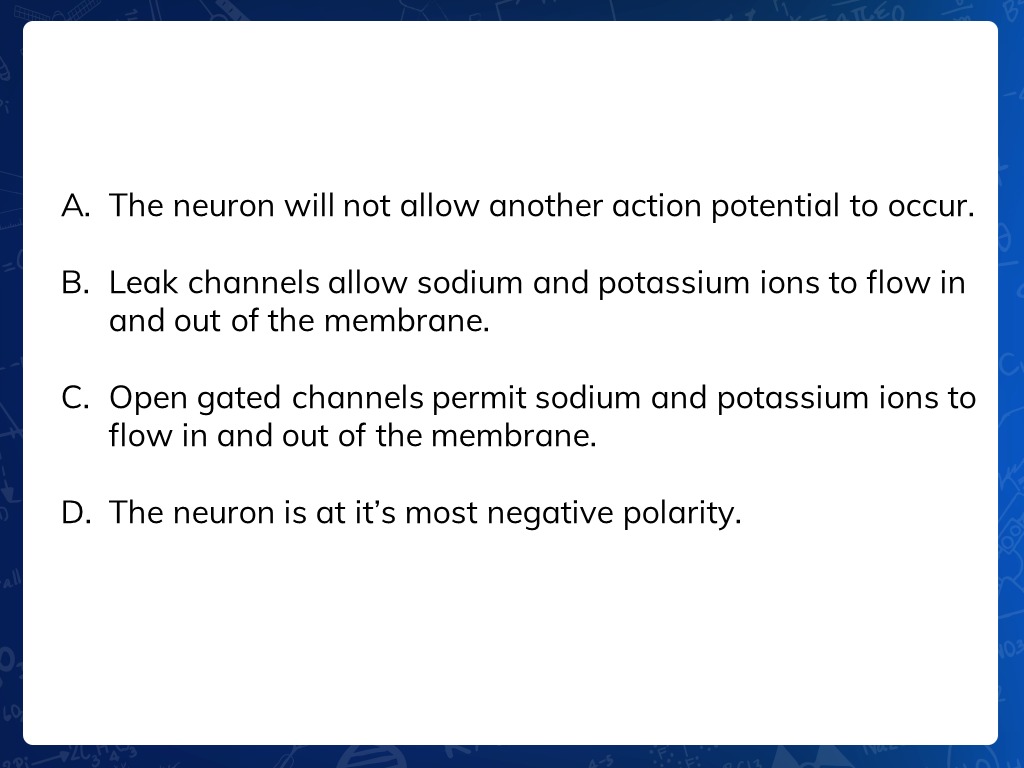
Synapse
The small gap between neurons (between the axon terminal and dendrite)
Neurotransmitters
Chemical messengers that cross the synaptic gap (synapse) between neurons.
When released by the initiating neuron, neurotransmitters travel across the synapse and binds to receptor sites on the receiving neurons. After unlocking the reception sites in the dendrites, they go on to trigger whether the neuron will stimulate a response or block it.
If the neuron is an airport, the neurotransmitters are the planes.
Reuptake
A neurotransmitter’s reabsorption by the sending neuron.
SSRIs prevent too much reabsorption from happening and thus a depletion of serotonin.
SSRIs (Serotonin Selective Reuptake Inhibitors).
SSRIs (Serotonin Selective Reuptake Inhibitors) are a medication class (namely for Prozac and Zoloft) designed to treat depression and other disorders. They selectively inhibit the reabsorption of serotonin (because too much absorption will leave scarce serotonin to be processed).
Note: reabsorption DOES occur, but SSRIs help selectively inhibit it so that TOO MUCH reabsorption doesn’t happen.
It’s like an inhibitor that stops you from wanting to unsend a text message; it lets you send it without retracting it.
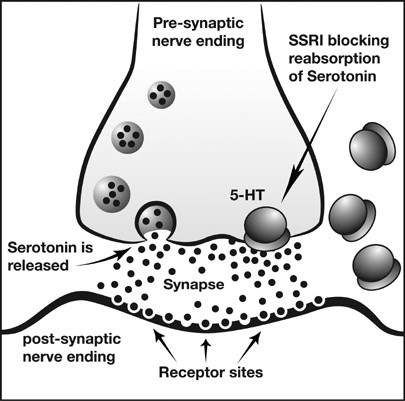
Endorphins
Meaning "morphine within”.
Our body’s natural opioid-like neurotransmitters linked to pain and pleasure.
Ex. When you are made to push through an arduous process, such as running, your body produces endorphins that carry you throughout the process.
Serotonin
(CNS) Central Nervous System - Chemical messenger regulating calm feelings in your body. Helps you realize “all is calm, I am fine”.
Dopamine
(CNS) Central Nervous System - The reward hormone that one gets after accomplishing or gaining something. (It’s not only a reward hormone but something that motivates us to complete a task to begin with).
While depression and anxiety medicine tend to be based on SSRIs, ADHD medication helps ensure that one has enough dopamine (because those with ADHD need far more dopamine than others).
Acetylcholine (AChs)
(CNS) Central Nervous System and (PNS) Somatic and Parasympathetic Nervous System - Neurotransmitter that influences learning, memory, and muscle action.
Think A in acetylcholine for Alzheimers — those with Alzheimers cannot regulate memory and learning.
Gamma-aminobutyric acid (GABA)
(CNS) Central Nervous System - Brain’s inhibitory neurotransmitter (a lack of it causes excessive activity and disregulation, such as insomnia and seizures). It tells the body to stop and slow down.
A lack of GABA leads to excessive activity— the body needs GABA to maintain regulation and calm.
Glutamate
(CNS) Central Nervous System - Brain’s excitatory neurotransmitter. It creates links between neurons that form the basis for learning and long term memory. An excess of glutamate leads to extreme overstimulation of the brain (think, why do people avoid MSG? Why do people like MSG? MSG brainrot)
Norepinephrine (noradrenaline)
(PNS) Peripheral Nervous System and some parts of (CNS) Central Nervous System -Neurotransmitter that determines fight or flight, alertness, and arousal. It elevates heart rate, alertness, respiration, etc.
Think of its second name— noradrenaline, “adrenaline”— and fight-flight reactions.
Made by the sympathetic nervous system.
Adrenaline (epinephrine)
Similar but different to norepinephrine. Helps jolt people with adrenaline, which increases alertness, heart rate, circulation, etc.
Epi-pens, epinephrine pens, are injected to those undergoing anaphylactic shock to keep them going until medical help is found.
Agonist
Molecule that increases a neurotransmitter’s actions.
Think agony in agonist— agony is prolonged, increasing a neurotransmitter’s actions.
Examples of agonists: morphine, heroin.
Antagonist
Molecule that inhibits or blocks a neurotransmitter’s actions.
Think antagonist, like a counter to the protagonist— they want to stop you.
Examples of antagonists: curare (poison) that causes paralysis.
Hormone
Chemical messengers that are manufactured by endocrine glands and travel through the bloodstream.
Pituitary gland
The pituitary gland is part of the endocrine system and is in the brain. It’s deemed the master gland which controls all others.
Psychoactive drug
A chemical substance that alters the brain, causing changes in perceptions and moods.
Note: not all of these are inherently bad— for instance, caffeine in regulation can aid in alertness and retaining memory.
Substance Use Disorder
When one lengthens their tolerance to a certain substance to the point where it seems they are dependent on it to self-regulate. Aka. Addiction.
One will abuse it (towards themselves and others). It will also debilitate social function and their physical health.
When one experiences withdrawal from the drug they are addicted to, they experience discomfort and disorienting sensations because they become dependent on their drug.
Perception vs. Sensation
Sensation: Sensing stimuli. (Ex. in hearing someone call out your name, you hear the sound and sense it with your ears)
Perception: Interpreting that stimuli. (Ex. recognizing “oh, thats xyz calling my name”).
Tolerance
The threshold or amount of a drug one needs to gain an effect or feeling. Over time, as an addiction develops, the threshold increases (you need more and more over time to fulfill your “need”).
Depressants
Drugs that act as inhibitors— they slow bodily functions and neural activity. A famous depressant is alcohol.
Includes alcohol, barbiturates and opioids.
Leads to poor memory, poor REM sleep, and loss of self awareness. Certain depressants, like alcohol, will lead to deterioration of the liver, shrinking of brain, and a premature death.
Barbiturates
Depressant drugs that depress central nervous system activity. It reduces anxiety, but in turn impair memory and judgement.
Barbiturates are a type of tranquilizer; they act like alcohol in that it impairs memory and judgement. They are never to be combined with alcohol as it is lethal.
Think barb in barbiturates — barbed wire; it’s supposed to stop you.
Opioids
Depressant consisting of opium and its derivatives (heroin, oxycontin, morphine, fentanyl); they depress neural activity and temporarily lessen pain and anxiety. Commonly prescribed after surgery or when enduring pain from a disease such as cancer.
Long term use of opioids can lead to increased cravings, tolerance distortion, and decreasing the production of natural endorphins in the brain.
Stimulants
The opposite of depressants. Instead of inhibiting like depressants, they elevate brain activity and alertness.
These drugs include caffeine, tobacco, and nicotine.
Nicotine
Stimulant drug which affects neurotransmitters like epinephrine and norepinephrine, leading to excessive alertness and “highs”. Withdrawal from nicotine can lead to perceived anxiety.
Amphetamines and methamphetamine
Stimulants that trigger intense releases of dopamine to enhance energy and mood.
A crash can result after use which leads to irritability, seizures, and violent outbursts.
Long term abuse will lead to debilitated natural dopamine production and thus depression. It will also debilitate one’s immune system, leading to open sores. It will consume one’s life if they fall in too deep.
Ecstasy (MDMA)
An amphetamine-based stimulant and hallucinogen which gives a burst of energy, elevated emotions, and social connectedness. It can also result in dehydration, overheating and death. Dehydration is key to identifying ecstasy.
Naturally-occurring serotonin neurons can be damaged by ecstasy use over time, which leads to impaired memory, poor sleep, poor immune system and depression.
Hallucinogens
Psychedelic drugs which distort perceptions and evoke false sensory images in the absence of sensory input.
They can be synthetic, like LSD and MDMA, or organic, like psilocybin or ayahuasca.
Near death experience
An altered state of consciousness which occurs after a near-death experience, resulting in an experience similar to drug-induced hallucinations.
Marijuana
Hallucinogen containing THC which is inhaled or consumed.
It can induce hallucinations, delusions, relaxation, and anxiety.
It impairs memory and reaction time and leads to depression, increased risk of/worsened psychosis, and suicidal behavior.
It can be used in a medicinal sense (aiding in nausea from cancer treatments, chronic pain, and muscle soreness)— in recent times, a more nuanced and positive outlook has been made regarding weed.
Cocaine
Stimulant drug which is often inhaled, leading to a rush of euphoria, confidence, and energy. It can lead to paranoia, depressive crashes, and cardiovascular stress.
Heroin
Depressant which induces major pain relief and a rush of euphoria. Prolonged usage can lead to depressed physiology and loss of natural endorphin production.
Psychological Dependence
When one feels as if they need a substance to cope with intense emotions and their struggles; substances are like an emotional crutch to them, and so without them life feels nigh-impossible.
Abuse
Using substances in harmful and dangerous ways (towards yourself or others). You can abuse substances even if you are not addicted.
Computerized Tomography (CT) Scan
Type of brain scan which reveals the structure of a person’s brain via x-ray technology.
CT scans look like horizontal “slices” of the brain at an angle above a person’s head.
Tomography stems from tomos, the greek word for cut. CT is a horizontal cut of the brain.
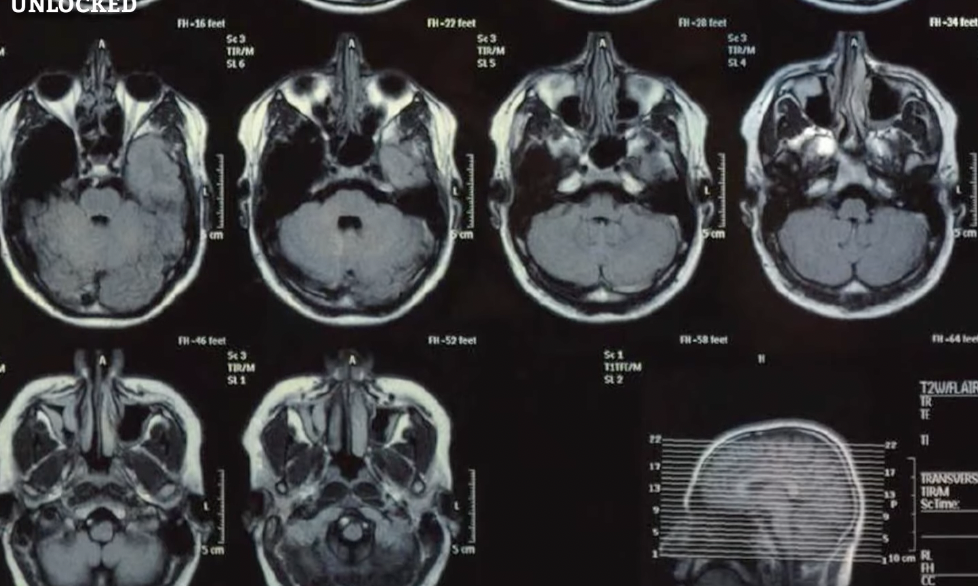
Magnetic Resonance Imaging (MRI)
Structural brain scan (displays structure) which operates by running a magnetic field over one’s head; the hydrogen molecules in the brain respond by sending a wave in response. These waves are recorded via a scanner and display a snapshot of the brain, displaying a full picture of the brain’s anatomy.
